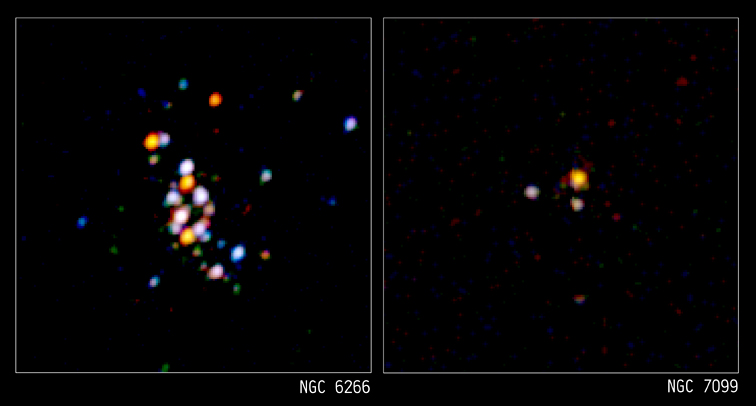
 Credit: NGC 6266 - NASA/CXC/MIT/D.Pooley et al.; NGC 7099 - NASA/CXC/UIn/H.Cohn & P.Lugger et al.
Credit: NGC 6266 - NASA/CXC/MIT/D.Pooley et al.; NGC 7099 - NASA/CXC/UIn/H.Cohn & P.Lugger et al.
Getting Closer
Stars tend to be solitary creatures, except very young stars and very old ones: they like to congregate. Young stars are typically found in associations called open clusters, while old stars form groups called globular clusters. Stars in globular clusters are packed relatively tightly - 100,000 or a million stars in a ball of a hundred or so lightyears in diameter. This means that the stars in globulars can interact more frequently than "field" stars, and perhaps should form denser stars and binary couples. X-ray images by the Chandra X-ray observatory of two globulars, NGC 6266 (left) and NGC 7099 (right) are shown above. X-ray observations are useful to pinpoint the location of compact X-ray binary stars, and the exquisite spatial resolution of Chandra is required in order to distinguish one star from a nearby neighbor. Chandra found that the number of X-ray binaries in NGC 6266, which is a relatively dense cluster, is much larger than the number found in NGC 7099, which is much more sparsely populated, relatively speaking. Such observations are helping astronomers to unravel the mysterious dynamics in the core of these old stellar groups.
Last Week *
HEA Dictionary * Archive
* Search HEAPOW
* Education
Each week the HEASARC
brings you new, exciting and beautiful images from X-ray and Gamma ray
astronomy. Check back each week and be sure to check out the HEAPOW archive!
Last modified ¥


